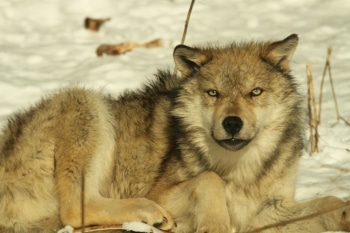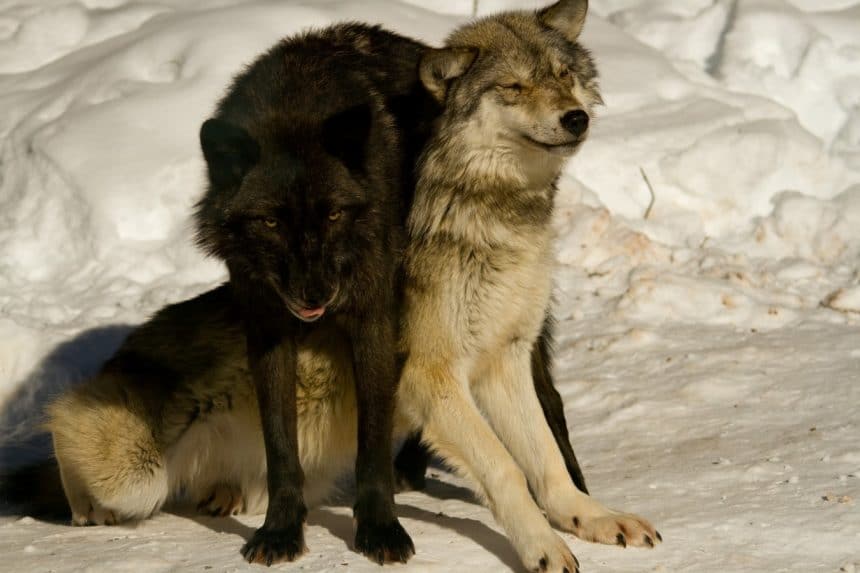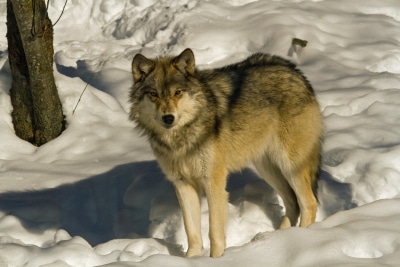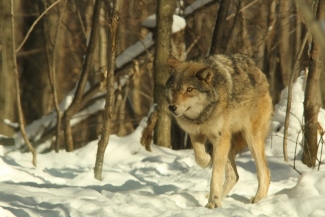If you have a chance, pick up the January/February issue of Canadian Geographic. It features Alanna Mitchell’s fabulous expose on the mixed emotions surrounding wolves throughout history.
This theme is perfectly portrayed by the saga that unfolded here at our Wolf Centre just over two years ago. Mitchell writes, “As far as anyone can tell, the incident at the Haliburton Forest Wolf Centre was the fatal intersection of two irreconcilable attitudes toward the wolf. The police and private investigations suggest that someone who loved wolves set them free; someone who hated them shot one on sight.
The year was in its last few bone-chilling hours when Peter Schleifenbaum got the call that a timber wolf from his 324-square-kilometre forest sanctuary near Haliburton, Ont., was on the loose. At first, he wasn’t too worried. Alarms like that happened every few months and, so far, all had been false.
Nevertheless, he abandoned his New Year’s Eve celebrations, hopped in his car, and rushed to check things out. It was far worse than he’d imagined. Gaping holes had been cut through the centre’s pair of encircling 2.5 and three-metre-high metal fences, allowing four of the pack’s nine wolves to get out. Given another 15 minutes, the remaining five would have followed.
Within hours, he found evidence that a big black male had been shot and killed just around the corner from the sanctuary. As 2013 began, three more wolves were on the run through the snowy yards of this cottage country holiday area. Schleifenbaum was desperate to lure them back inside their pen. Could he save them before anything else happened?”
Mitchell paints a chilling image then leaves the reader breathless as she provides some background on the opposing views of wolves, introducing some historical tales, evolution and specialist opinions. A full page later, she weaves back into Haliburton Forest.
“As New Year’s Day 2013 dawned, Schleifenbaum was calculating the losses. Wolves are highly social animals, living in packs with tightly defined hierarchies. One male and one female take the lead and only they breed. They’re called the alphas, named after the first letter in the Greek alphabet. When the two fences were cut at Schleifenbaum’s reserve, the alphas led the way out and the two strongest males followed, leaving behind only the weakest members: five females.
It represented the destruction of the wolves’ social structure and possibly the end of the pack itself. Schleifenbaum vowed to do everything he could to get the wolves back. His team set up live baited traps that would keep the wolves safe if they ventured in. Two of the escaped wolves hung around the enclosure and even bedded down near their pack mates inside, but bolted whenever anyone got close enough to shoot them with a tranquilizer. As the days passed, the wolves started roaming farther and farther away. But Schleifenbaum was certain they would return for good.
Then, on the 10th day, horrible news: The alpha female, a sturdy grey with eerie yellow eyes who had ruled the pack for four years and borne two litters of pups, was found shot in a ditch, barely alive, blood soaking the snow beside her. The staff took her back to the centre, called in the vet and tried to cajole her into eating raw sausage. She died three days later.
In the meantime, two more wolves, the strong black alpha male and his feisty grey son, were at large, roaming backyards right alongside cottagers’ tasty pet dogs and cats. Were sharp-shooters out there looking for them, too?”

“Schleifenbaum is just a few metres from his wolves, inside the enclosure but behind a fence, stepping nimbly over a growing puddle of beaver blood. The smell of thawing skinned beaver carcass is overpowering in the midday heat and so is the frenzy of the wolves, snapping powerful jaws and growling fiercely as they jump for it in vain.
Holding a beaver by its flat tail, he chucks it over the fence and the wolves pounce. One of them captures the prize and immediately carries it to a choice feeding spot, hungrily ripping out its guts, gobbling down the meat and fending off the other wolves. Upstairs behind one-way glass in the viewing chamber, about 30 visitors are watching the riveting spectacle.”
Mitchell, an award-winning author and journalist, chooses to wrap up the situation in the same way we do here at Haliburton Forest: with optimistic realism.
“‘As you can see, this is not a real glitzy job,’ Schleifenbaum says as he stoops to pick up another bloody beaver. It’s been almost two years since someone let the wolves out. Schleifenbaum brought in a new male who successfully bred with one of the females to produce four new pups, three of which are now vying for beaver bones a few metres away – making them the new alpha pair.
The two remaining escaped wolves never returned. They haven’t been sighted since the start of 2013’s bitterly cold winter. Schleifenbaum is pretty sure they’re dead – shot or starved. By a cruel twist of fate, the people who loved the animals enough to liberate them have succeeded in fulfilling the wishes of those who hate wolves, who say the only good wolf is a dead one.
The wolves are fed, for now, and two of them are playing tug-of-war with the guts of one of the thawed beavers. More visitors are crowding into the viewing chamber every minute to watch. For Schleifenbaum, who holds a PhD in forestry, this is all about education. He grew up in Germany, where wolves were killed off in the 1800s, and he wants to teach people that the animals are neither noble nor evil; they’re just part of a natural ecosystem.
But it hasn’t been easy. Just opening the place almost 20 years ago here in the forest he owns was controversial because some residents said wolves were too many. And then, in April 1996, a few months before the centre was to officially open, several of its captive wolves ganged up on Patricia Wyman, a 24-year-old biologist less than a week into her job, and killed her. It was like every nightmarish, wolf tale come true. The wolves were killed and wolf biologists such as the Theberges still talk about the bad press.
But the centre opened three months later and now boasts 30,000 avid visitors a year. If there’s a bright side to the fence incident, it’s that Schleifenbaum’s dream of wolf ambassador-ship may be working. When the fences were cut, no one called for a lockdown or helicopters or police with guns. People would phone up and say: ‘I saw your wolf in my backyard. How beautiful it is. What an amazing experience.’”
Thank you to Alanna Mitchell and Canadian Geographic for the opportunity to share our story and to help fulfill the Wolf Centre’s goal of education. The debate about wolves will continue and no matter your stance on the subject, the criminal activity that occurred here and the chilling fallout represent the pinnacle of the contradiction that exists among human sentiments regarding the largest remaining Canid, the wolf.
Thanks also to John Cavers for an unending supply of wonderful photographs.
Juliette Arsenault




